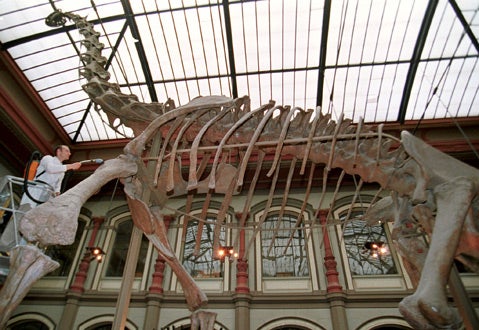Dinosaur remains 'may be new species'

Palaeontologists have found extensive remains of a 120 million-year-old dinosaur near the remote village of Morella in eastern Spain, which they say could belong to a hitherto undiscovered species.
Remains so far uncovered of a Sauropod dinosaur linked to the Brachiosaurus family are virtually intact, giving scientists hope they will eventually recover most of the giant animal´s bone structure, a palaeontologist leading the excavation said today.
"It's a very exciting find, because you rarely come across the bones in their original skeletal shape," Jose Miguel Gasulla, one of four leaders of the dig in the Valencia region, said today.
When striding the Iberian mountains on all four feet, the dinosaur must have been up to 25m long and weighed up to 40 tons, Mr Gasulla reckons. The creature with its characteristic long neck and tail was a member of the Brachiosaurus group, more commonly referred to as the giraffe-type, which held its head high, some 11m above the ground.
"We have found vertebrae, ribs and a thigh bone of a very big adult dinosaur from the early Cretaceous period,"Mr Gasulla said today, speaking by telephone from the site. "It's also enormous. We first found a femur [thigh bone] 1.80m long, articulated with the hip, then bigger and bigger ribs, up to 2.40m."
The remains date from the early Cretaceous period, some 120 million years ago. Most Brachiosaurus remains have been found from the preceding Jurassic period. "Those from the early Cretaceous period are much less common, and one of this size is vary rare, so we are able to advance our knowledge of the group in this period," Mr Gasulla said.
Scientists want to establish whether their find is a new species of the family or directly related to others already discovered. "We want to situate this dinosaur in the context of Sauropod dinosaurs. We have considerable hope that it may be a new species, linked to the Brachiosaurus, and for which we'd have to find a new name."
The 14-strong excavation team are extracting the bones they uncover, "but its very delicate work," Mr Gasulla says. The vertebrae are big, but fragile, filled with air cavities to make them lighter. "If you have a neck six to eight metres long, how do you lift that huge weight? So the bone content was reduced by air holes."
Palaeontologists are digging down into a remote hillside covered in ancient holm oak woodlands, and Mr Gasulla declines to estimate how long it will take to excavate the full skeleton. "We´ll have to shore it up, strengthen it with polyurethane, lift it with a crane - it'll take ages".
The region, known as the Maestrazgo, is rich in dinosaur remains, and the site between the towns of Morella and Cinctorres was spotted as promising in 2002. But excavation began only in 2005, when the project obtained funds, initially from a wind energy company, then from Valencia's regional government.
Authorities also fund a proposed dinosaur museum in Morella, Mudin, with which Mr Gasulla is enthusiastically involved. The museum, due to open shortly, will include entertaining visual displays for the lay visitor, and a "scientifically rigorous" research centre for professionals investigating the excavations roundabout, he says.
Join our commenting forum
Join thought-provoking conversations, follow other Independent readers and see their replies
Comments
Bookmark popover
Removed from bookmarks